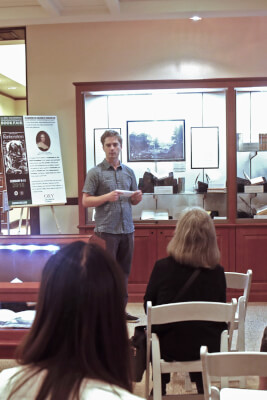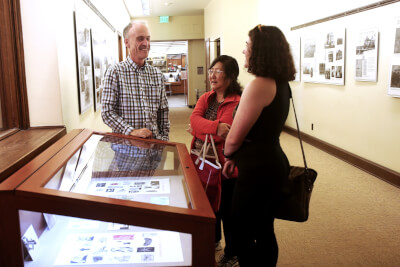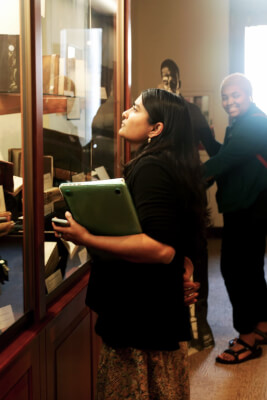
To celebrate the 200-year anniversary of Mary Shelley’s novel, “Frankenstein,” Talking Books and Special Collections hosted the event, “The Gregarious Monster” in the Occidental Library Gallery Oct. 30. The event featured a lecture by Core Program professor Devin Fromm, who talked about a variety of topics and influences in the novel, and an exhibit with the first edition of the novel curated by Special Collections Instruction Research Librarian Helena de Lemos. According to Fromm, people discuss the novel 200 years later because the book explores many themes that are relevant today. One of these themes includes humans taking responsibility for their actions in an increasingly technological world.
In his talk, Fromm addressed the ideas of science in the book, its ethical restraints and the political-aesthetic community that people want to live in as the world changes at a rapid pace. According to Fromm, “Frankenstein” is Mary Shelley’s response to the transformations in science, technology, travel and information that occur in the world throughout the 19th century.
“What ‘Frankenstein,’ her novel, does is respond in the most extravagant way possible. It wrestles the world to the ground,” Fromm said.
The dominant idea that Fromm discussed was the advancement of science and how the question of what science is supposed to do will always be extremely relevant. In Fromm’s opinion, scientists today forget to ask what their knowledge is used for. This is dangerous because science itself has proven to be so powerful that the questions surrounding the purpose of a scientist’s research are increasingly necessary and increasingly less questioned.

“He cobbles together pieces of animal and humans to build and reinvigorate a monster. And that sticks with us, obviously,” Fromm said. “It really represents a philosophical tug of war that goes underway during the time about what science is and what is it supposed to do.”
Hannah White (junior) read “Frankenstein” before and attended the event because she was excited that Occidental put on an event commemorating a woman author. Additionally, the Cultural Studies Program (CSP) class she took during her first year at Occidental was about “Frankenstein” and its pertinence today.
White said Victor Frankenstein creates a monster who everyone thinks is horrible and harmful simply based on his ugly appearance. However, what White appreciates is how Shelley created a larger message about how there are two sides to any story.
“The fact that the second half of the book switches into the narrative of the monster is really important,” White said. “It shows that just because on the outside you can look a certain way and have certain expectations of you doesn’t necessarily mean that’s what you feel on the inside.”
Her favorite artifact at the event was the first edition of the book because she wanted to have the opportunity to see what it looked like in person. As an English major, White said she was able to appreciate all the literature that surrounded “Frankenstein,” as well as “Frankenstein” itself.
“A lot of what Special Collections has is kind of hidden away, so I like when they do stuff like this,” White said.
After researching the process behind “Frankenstein,” Helena de Lemos pulled artifacts that inspired the book out of Special Collections for the display. According to de Lemos, Special Collections showcased two collections for the Gregarious Monster event that inspired and showcased Shelley’s novel. One of the collections included mystery-detective fiction artifacts and the first edition of “Frankenstein.” The other collection included English Romanticism literature that was donated to Occidental by one of the founder’s sons. Similar to how Victor Frankenstein composed a creature made of many small pieces, de Lemos said that she wanted the Gregarious Monster collection to be comprised of books that both influenced Shelley and were influenced by Shelley, as well as other primary documents that helped compose the world of “Frankenstein.”

“Aesthetically reading the book, it does read in such a strange way to us now. It’s convoluted. It’s three long letters. I mean, who writes letters like that?” de Lemos said. “I don’t think that language is particularly beautiful, but the ideas have so many layers.”
De Lemos said that she feels people who have never read “Frankenstein,” and never will read it, still have a connection to the book from a movie they saw or other books they have read. Despite the increase in technology and communication throughout the world, de Lemos believes that it still fails to replace real human connection.
“The Creature becomes deranged because he’s not loved,” de Lemos said. “He’s seeking connection, and he tries to meet people, but they all run away from him because he’s too ugly. So, I also think this need for human connection is a big part of the book.”
![]()



































